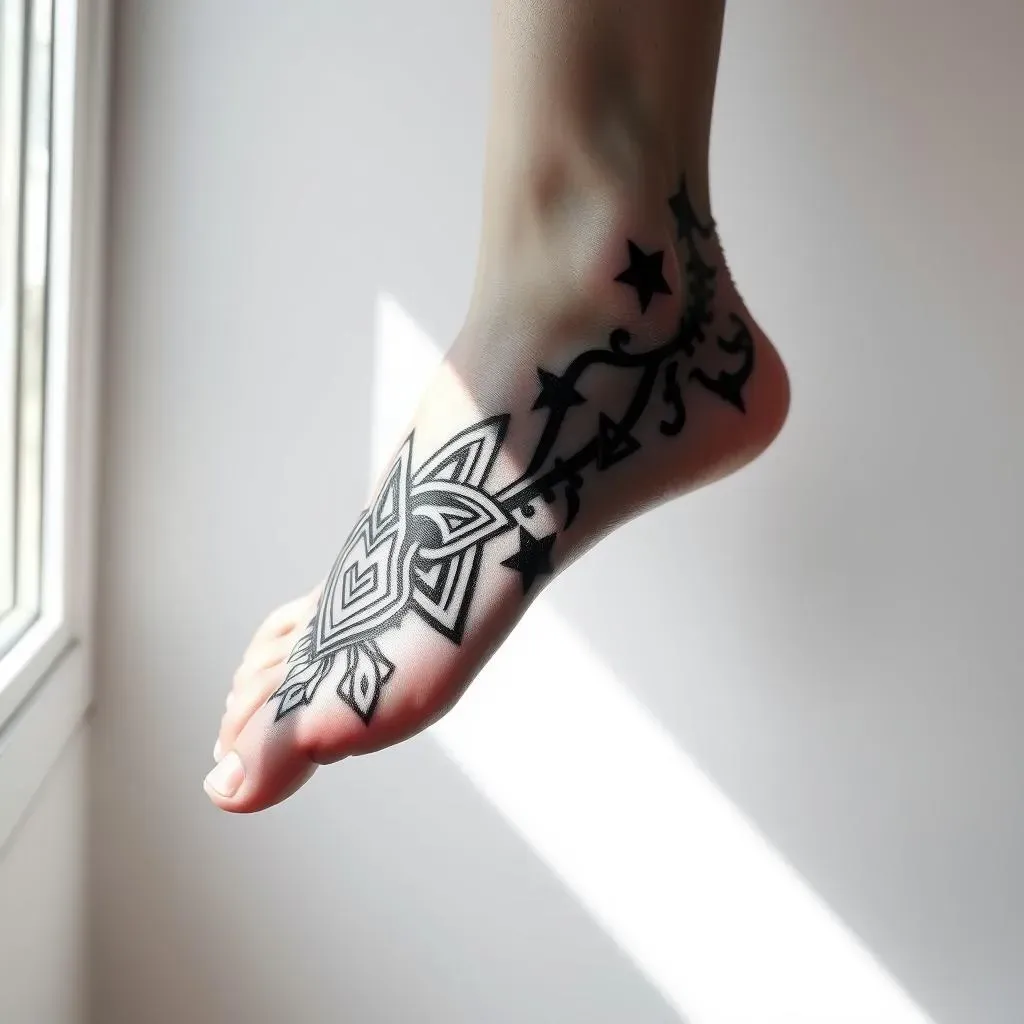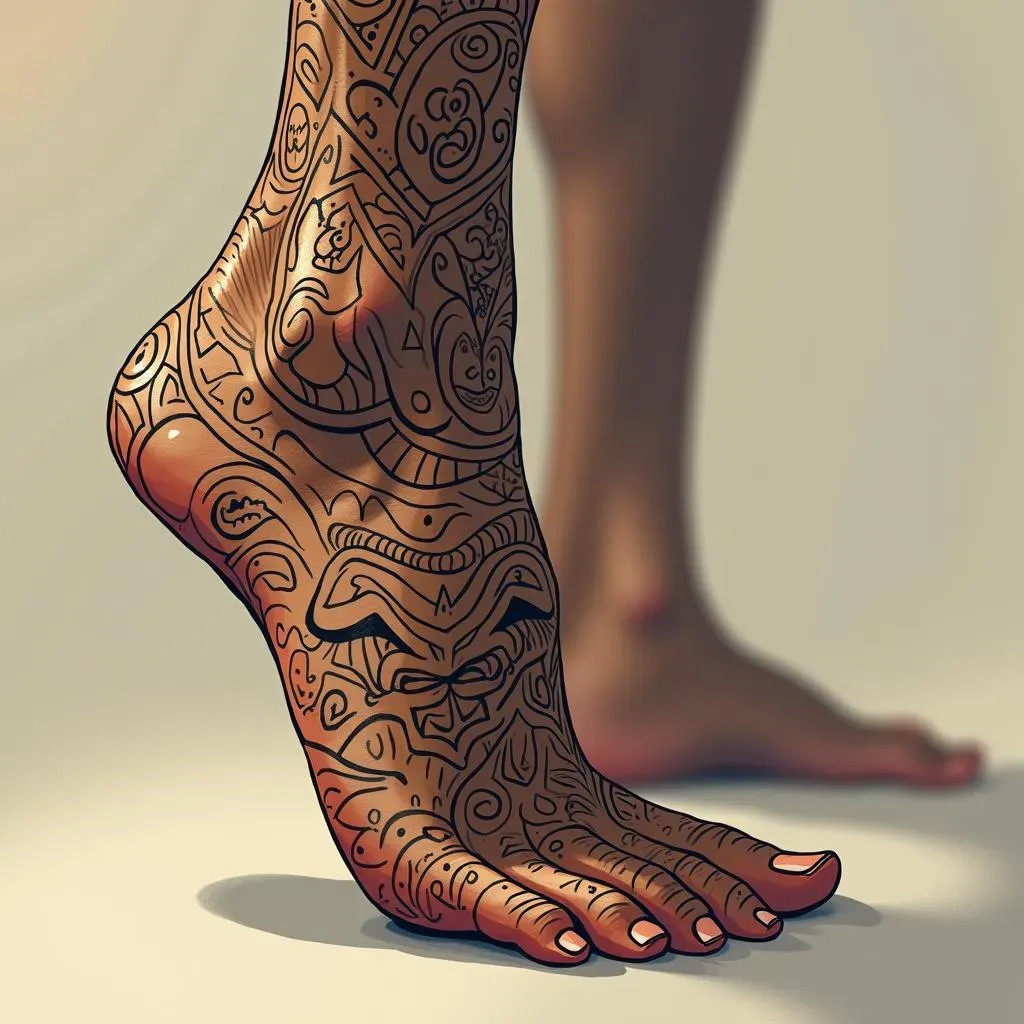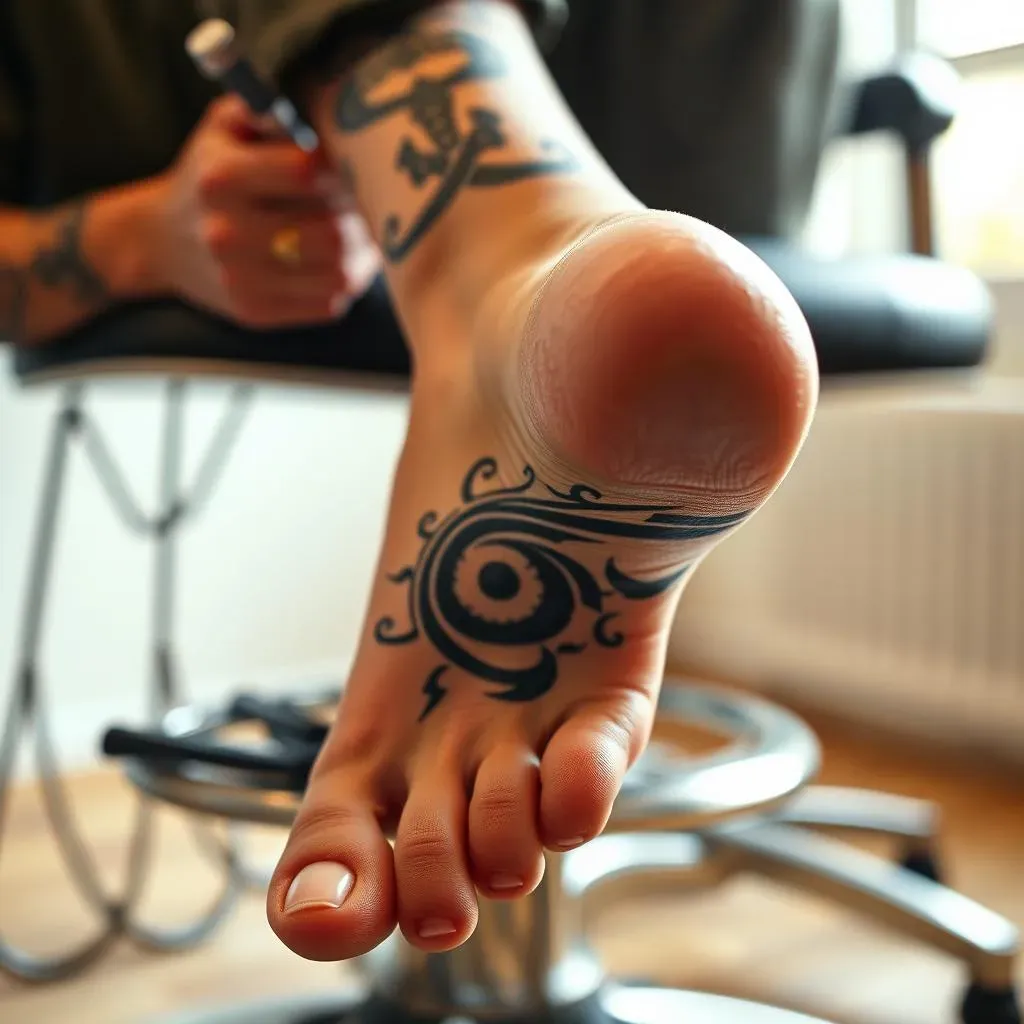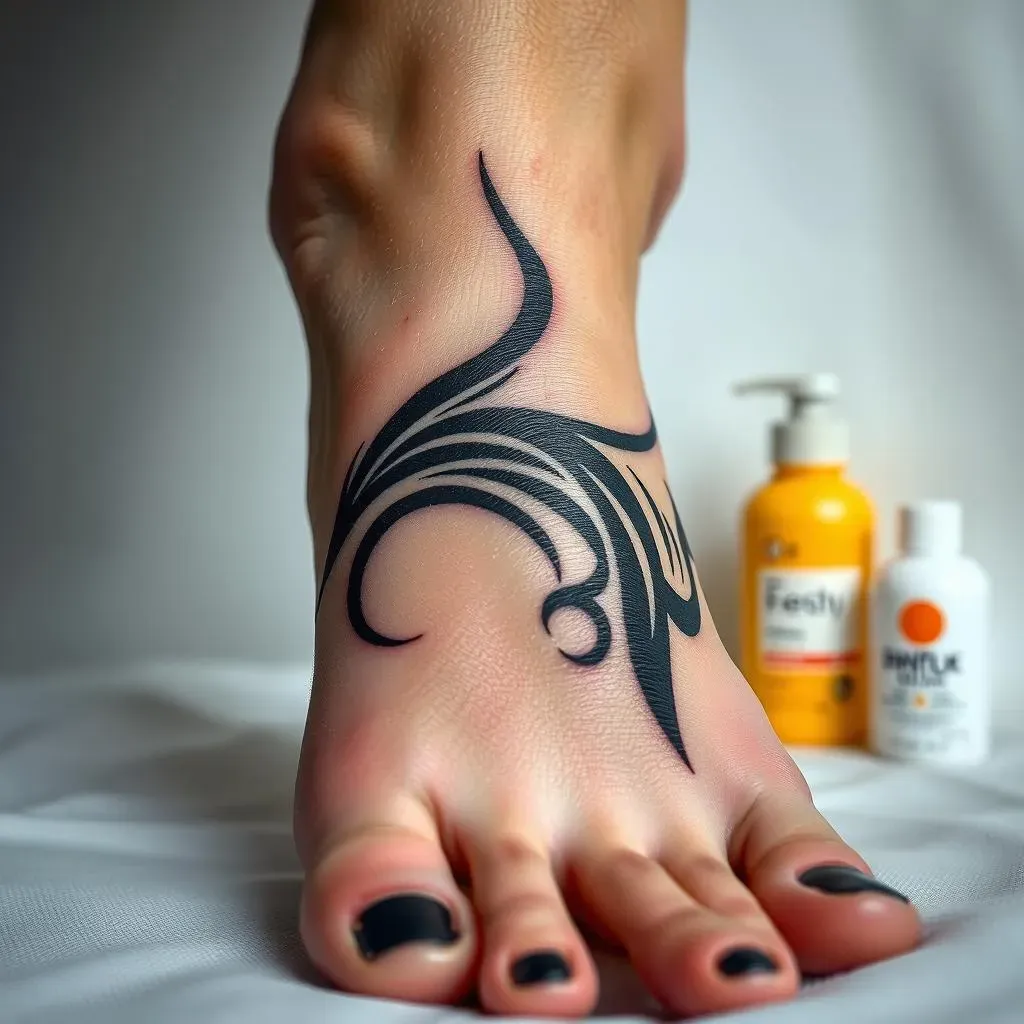Table of Contents
Ready to unleash your inner artist and adorn your feet with captivating ink? This article is your ultimate guide to the world of black and grey tribal foot tattoos for women. We'll explore the artistry behind these intricate designs, examining the diverse range of tribal styles available to create a look that's uniquely you. From delicate anklet-style pieces to bolder, more statement-making designs, we’ll delve into the creative possibilities. We'll also discuss the crucial aspects of placement and size, ensuring your tattoo complements your foot's shape and personal style. Choosing the perfect location and dimensions is key to achieving a stunning result. Finally, we'll provide practical aftercare advice to keep your black and grey tribal foot tattoo looking its best for years to come. So, whether you're a seasoned tattoo enthusiast or a curious newcomer, let's embark on this journey of self-expression together and discover the perfect black and grey tribal foot tattoo for you.
Choosing the Perfect Black and Grey Tribal Foot Tattoo

Choosing the Perfect Black and Grey Tribal Foot Tattoo
Understanding Your Style
Before you even think about stepping into a tattoo parlor, take some time to reflect on your personal style. What kind of aesthetic resonates with you? Do you prefer bold, graphic designs or something more delicate and intricate? Think about your wardrobe – are you drawn to minimalist styles or something more bohemian? Your tattoo should be an extension of yourself, so choosing a design that aligns with your overall aesthetic is paramount. Browse online galleries, Pinterest boards, and tattoo artist portfolios for inspiration. Don't just pick the first cool image you see; let the design speak to you.
Consider the symbolism associated with different tribal styles. Polynesian tribal tattoos, for example, often incorporate deep cultural meanings related to ancestry, spirituality, and family. Other styles, like those originating from Native American or African cultures, also have rich histories and potent symbolism. Researching these meanings beforehand will ensure you choose a design that genuinely resonates with you and your values.
Style | Characteristics | Considerations |
|---|---|---|
Geometric | Sharp lines, angular shapes, often abstract | Modern, bold, versatile |
Floral | Curving lines, flowing patterns, often incorporating natural elements | Feminine, delicate, elegant |
Animalistic | Depictions of animals, often symbolic | Powerful, meaningful, culturally significant |
Choosing the Right Size and Placement
The size and placement of your tattoo will significantly impact its overall look and feel. A small, delicate design might be perfect for the side of your foot, while a larger, more intricate piece might suit the top or instep. Consider your foot’s shape and bone structure. A long, slender foot might look best with a vertical design, while a wider foot might suit a horizontal design. Also, think about how much skin you want the tattoo to cover. Do you want a small, subtle design, or something more eye-catching?
Remember that your foot is a highly visible area, especially during warmer months. Choose a placement that you're comfortable with and that you won't regret later. Think about how the tattoo will look with your shoes and clothing. For example, a large tattoo on the top of your foot might be difficult to conceal, while a smaller tattoo on the side of your foot can be easily hidden.
- Consider your pain tolerance – some areas of the foot are more sensitive than others.
- Think about your lifestyle – how much time do you spend barefoot versus wearing shoes?
- Discuss your options with a professional tattoo artist – they can provide expert advice and guidance.
Finding the Right Artist
The quality of your tattoo depends heavily on the skill and experience of your artist. Don't settle for just anyone; research local tattoo artists who specialize in black and grey work and tribal designs. Look at their portfolios online. Do their styles align with your vision? Do they have a strong reputation for clean lines and precise execution? Pay attention to the detail in their work – are the lines crisp? Are the shading techniques well-executed? A skilled artist will be able to bring your vision to life with stunning accuracy.
Don't be afraid to schedule consultations with several artists before making a decision. This allows you to discuss your ideas in detail, get a feel for their personality and approach, and ensure that you’re a good fit for each other. A good artist will be happy to answer your questions, address your concerns, and offer suggestions. Remember, this is a permanent decision, so take the time to find the right artist for you. The process should be collaborative and enjoyable.
Design Inspiration: Exploring Tribal Styles for Foot Tattoos

Design Inspiration: Exploring Tribal Styles for Foot Tattoos
Delving into Tribal Aesthetics
So, you're ready to explore the fascinating world of tribal tattoo designs? Fantastic! The beauty of tribal art lies in its diversity. We're not just talking about one style; we're talking about a rich tapestry of influences from cultures across the globe. Polynesian tribal tattoos, for instance, are renowned for their intricate patterns and bold lines, often depicting symbolic figures and imagery. These designs frequently incorporate elements like spirals, waves, and geometric shapes, each carrying its own unique meaning and significance. Think about the powerful imagery of a traditional Maori design or the flowing lines of a Samoan tattoo – both styles offer a wealth of inspiration for your foot tattoo.
Then there are Native American tribal tattoos, which are equally diverse and captivating. These designs often feature animals, natural elements, and geometric patterns specific to various tribes and nations. Each tribe has its unique artistic traditions, resulting in a wide array of styles and symbols. Consider the symbolic power of a wolf, the grace of a feather, or the strength of a bear – these powerful images could be incorporated into your design. Remember, it's crucial to approach these designs with respect and understanding of their cultural significance.
Tribal Style | Key Characteristics | Suitable for Foot Tattoos? |
|---|---|---|
Polynesian | Intricate patterns, bold lines, symbolic figures | Excellent, especially for larger designs |
Native American | Animals, natural elements, geometric patterns | Yes, versatile and adaptable to various sizes |
African | Geometric shapes, abstract forms, bold colors (though we're focusing on black and grey here) | Very suitable, can create striking minimalist or intricate designs |
Exploring Variations Within Tribal Styles
Don't limit yourself to just one broad tribal category! Within each style, there's a huge amount of variation. For example, Polynesian tattoos can range from incredibly detailed and elaborate designs covering large areas of skin to smaller, more minimalist motifs. You can customize these styles further by incorporating personal elements or blending different tribal influences. Imagine a Polynesian-inspired design incorporating floral elements or a Native American style with geometric accents. The possibilities are endless!
Similarly, within Native American styles, the diversity is remarkable. Different tribes have their own distinct artistic traditions and symbolic languages. Some designs might feature animals, while others focus on geometric patterns or abstract forms. Researching specific tribal styles will give you a deeper appreciation for the rich history and cultural significance behind these designs. This research will help you choose a tattoo that not only looks great but also holds personal meaning.
- Consider incorporating personal symbols or meaningful dates into your design.
- Think about color palettes – even within black and grey, there's a spectrum of shades and tones.
- Experiment with different line weights and textures to create depth and visual interest.
Placement and Size: Considerations for Foot Tattoos

Placement and Size: Considerations for Foot Tattoos
Prime Real Estate: Choosing the Perfect Spot
Okay, so you've got your killer black and grey tribal design picked out. Now for the fun part: deciding where on your foot this masterpiece will live. The foot, my friend, is a surprisingly versatile canvas. Think about the different zones: the top of the foot (the instep), the sides, the ankle, even the toes (though those can be tricky!). Each area offers a unique aesthetic and level of visibility. A large, intricate design might look amazing spanning the instep, while a smaller, delicate piece could be perfect nestled on the side of your foot, peeking out from your sandals. Consider how much skin you want to cover and how visible you want your tattoo to be.
Think practically too! How much time do you spend barefoot versus wearing shoes? A prominent design on the top of your foot might face more wear and tear, so think about how that might affect the longevity of your tattoo. Also, consider your footwear choices. Do you primarily wear open-toed shoes or closed-toe styles? This will influence how often your tattoo is on display and, therefore, how much it's exposed to the elements.
Foot Area | Visibility | Design Suitability |
|---|---|---|
Instep | High | Larger, intricate designs |
Sides of Foot | Moderate | Smaller, more delicate designs |
Ankle | Moderate to Low (depending on footwear) | Anklet-style designs, smaller pieces |
Size Matters: Scaling Your Tribal Masterpiece
Now let's talk size. This is a critical decision that will greatly influence the final look of your tattoo. A small, minimalist design can be incredibly elegant and subtle, perfect for those who prefer a less-is-more approach. It can also be a great starting point for those new to tattoos. A larger piece, on the other hand, allows for more detail and complexity, making it a fantastic option for those who want a statement piece. But remember, bigger doesn't always mean better. It's all about finding the right scale that complements your foot's shape and the overall design.
Before you commit, consider the long-term implications of your choice. A large tattoo might be more difficult to conceal if necessary, while a smaller tattoo will be easier to hide under shoes or socks. Think about the potential for distortion as your foot ages or changes shape. A well-placed, appropriately sized tattoo will age gracefully, while a poorly chosen size and placement might not. Remember, your tattoo artist can provide expert advice on the best size and placement for your chosen design and the unique shape of your foot.
- Consider the proportion of the design to the size of your foot.
- Think about the level of detail you want to incorporate.
- Discuss your options with your tattoo artist to ensure a flattering and well-proportioned design.
Aftercare and Maintenance: Keeping Your Black and Grey Tribal Foot Tattoo Looking Its Best

Aftercare and Maintenance: Keeping Your Black and Grey Tribal Foot Tattoo Looking Its Best
The First Few Days: Protecting Your New Ink
The first few days after getting your tattoo are crucial for its healing and longevity. Your artist will likely apply a bandage; leave this on for the recommended time (usually a few hours). Once removed, gently cleanse the area with a mild, fragrance-free soap and lukewarm water. Pat it dry with a clean paper towel—avoid rubbing! Apply a thin layer of unscented, fragrance-free, petroleum-based ointment (like Aquaphor or Vaseline). This will keep the tattoo moisturized and prevent scabbing. Avoid harsh soaps, lotions, and perfumes, as these can irritate the healing skin and potentially damage your new tattoo.
Keep the area clean and dry. Avoid tight-fitting shoes or socks, especially during the initial healing period. These can trap moisture and increase the risk of infection. Instead, opt for loose-fitting footwear that allows air to circulate. Regularly inspect your tattoo for any signs of infection, such as excessive redness, swelling, or pus. If you notice anything unusual, contact your tattoo artist or a doctor immediately. Prevention is key, so following these steps carefully will help ensure your tattoo heals properly.
Day | Action | Important Note |
|---|---|---|
1-3 | Cleanse gently, apply ointment, keep dry | Avoid tight clothing |
4-7 | Continue cleansing, switch to unscented lotion | Avoid direct sunlight |
7-14 | Moisturize regularly | Monitor for any signs of infection |
Long-Term Care: Keeping Your Tattoo Vibrant
Once your tattoo is fully healed (usually 2-4 weeks), your aftercare routine shifts to long-term maintenance. Continue to moisturize your tattoo regularly, especially during dry weather. This will help keep the ink vibrant and prevent fading. Use a high-quality, unscented lotion specifically designed for tattoos. Avoid harsh chemicals and abrasive substances that can damage the skin and dull the ink. Sun exposure is a major culprit in tattoo fading, so always apply a broad-spectrum sunscreen with an SPF of 30 or higher whenever your tattoo will be exposed to the sun. This is crucial for preserving the vibrancy of your black and grey tribal design.
Consider the placement of your tattoo when choosing your footwear. Avoid shoes that rub or chafe against the area, as this can cause irritation and potentially damage the ink. If you notice any signs of fading or damage, contact your tattoo artist for advice. They can recommend products or treatments to help restore the vibrancy of your tattoo. Remember, a little preventative care goes a long way in ensuring your tattoo remains a beautiful and lasting piece of art.
- Use a high-quality, unscented lotion.
- Apply sunscreen with SPF 30 or higher.
- Avoid harsh chemicals and abrasive substances.
- Regularly inspect your tattoo for any signs of damage.
Addressing Common Concerns
Let's be real, foot tattoos present some unique challenges. The skin on your feet is constantly exposed to friction from shoes and socks, and it's also prone to dryness. This can lead to some common issues like fading or slight damage to the ink. To minimize fading, keep your tattoo moisturized and avoid prolonged sun exposure. Regular moisturizing with a high-quality lotion will help keep the skin hydrated and prevent the ink from drying out and becoming dull. If you notice any areas of dryness or cracking, address them promptly with a good moisturizer to prevent damage.
Another concern is the risk of infection. Because your feet are constantly in contact with shoes and socks, it's important to keep the area clean and dry. Avoid wearing tight-fitting shoes, especially during the healing process. If you notice any signs of infection, such as redness, swelling, or pus, seek medical attention immediately. Early treatment is crucial to preventing serious complications. Proper aftercare is your best defense against infection. With a little care and attention, you can keep your beautiful black and grey tribal foot tattoo looking its absolute best for years to come.